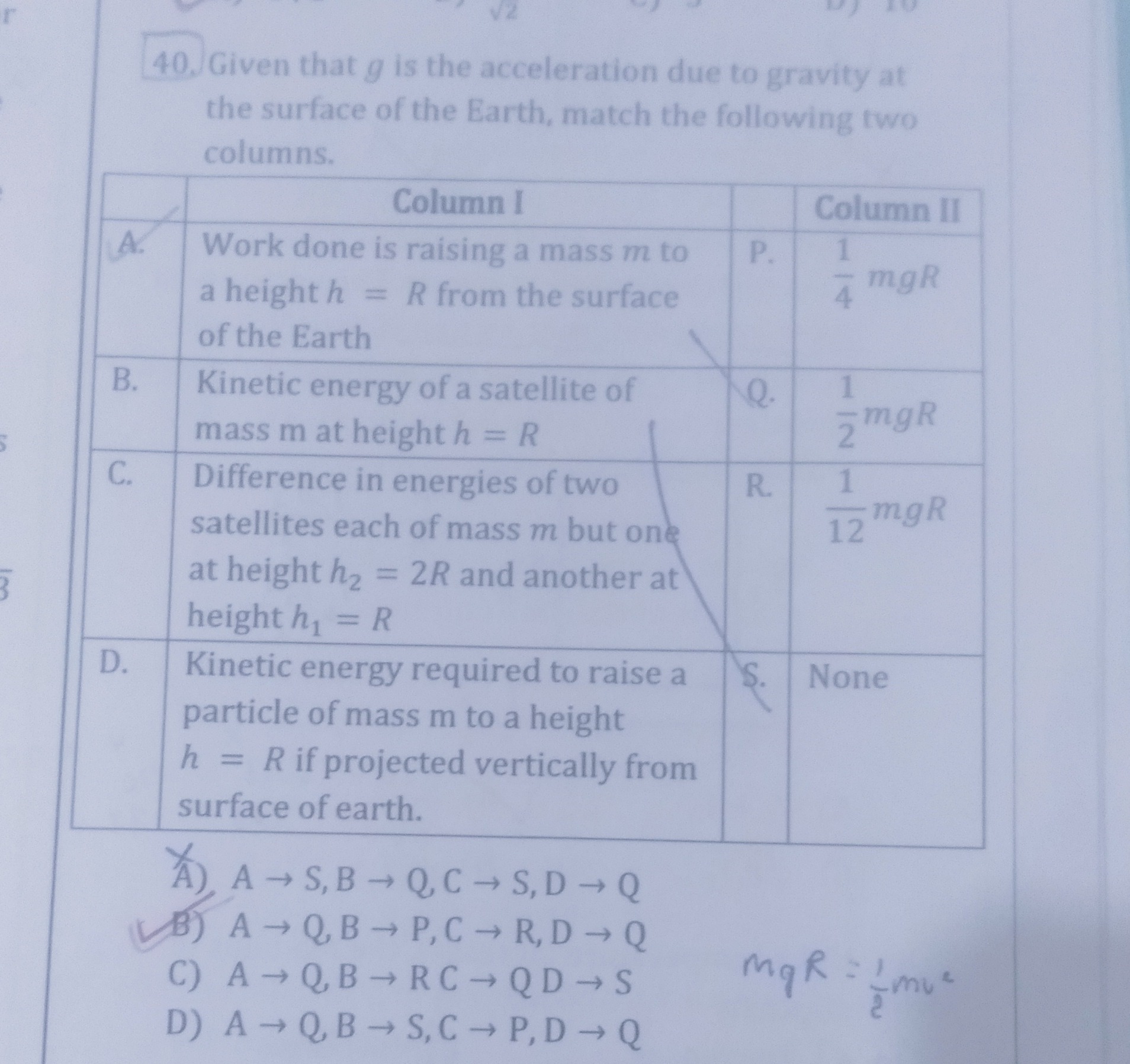Question
Question: Given that g is the acceleration due to gravity at the surface of the Earth, match the following two...
Given that g is the acceleration due to gravity at the surface of the Earth, match the following two columns.
| Column I | Column II | ||
|---|---|---|---|
| A. | Work done is raising a mass m to a height h = R from the surface of the Earth | P. | 41mgR |
| B. | Kinetic energy of a satellite of mass m at height h = R | Q. | 21mgR |
| C. | Difference in energies of two satellites each of mass m but one at height h2=2R and another at height h1=R | R. | 121mgR |
| D. | Kinetic energy required to raise a particle of mass m to a height h = R if projected vertically from surface of earth. | S. | None |

A→S, B→Q, C→S, D→Q
A→Q, B→P, C→R, D→Q
A→Q, B→R C→Q D→S
A→Q, B→S, C→P, D→Q
B) A→Q, B→P, C→R, D→Q
Solution
The acceleration due to gravity at the surface of the Earth is given by g=R2GM, where M is the mass of the Earth and R is the radius of the Earth. This relation can be written as GM=gR2.
Let's evaluate each item in Column I:
A. Work done in raising a mass m to a height h = R from the surface of the Earth.
The initial position is at the surface (r1=R). The potential energy is U1=−RGMm.
The final position is at a height h=R from the surface, which is a distance r2=R+h=R+R=2R from the center of the Earth. The potential energy is U2=−2RGMm.
The work done against gravity is the change in potential energy:
W=U2−U1=−2RGMm−(−RGMm)=RGMm−2RGMm=2RGMm.
Using GM=gR2, we get W=2RgR2m=21mgR.
So, A matches with Q.
B. Kinetic energy of a satellite of mass m at height h = R.
A satellite in a circular orbit at a height h has an orbital radius r=R+h. For h = R, the orbital radius is r=R+R=2R.
For a stable circular orbit, the gravitational force provides the centripetal force:
r2GMm=rmv2, where v is the orbital speed.
The kinetic energy of the satellite is K=21mv2. From the orbital equation, v2=rGM.
So, K=21m(rGM)=2rGMm.
For a satellite at height h = R, r=2R.
K=2(2R)GMm=4RGMm.
Using GM=gR2, we get K=4RgR2m=41mgR.
So, B matches with P.
C. Difference in energies of two satellites each of mass m but one at height h2=2R and another at height h1=R.
The total energy of a satellite in a circular orbit at radius r is E=K+U=2rGMm−rGMm=−2rGMm.
For the satellite at height h1=R, the orbital radius is r1=R+h1=R+R=2R. The energy is E1=−2r1GMm=−2(2R)GMm=−4RGMm.
For the satellite at height h2=2R, the orbital radius is r2=R+h2=R+2R=3R. The energy is E2=−2r2GMm=−2(3R)GMm=−6RGMm.
The difference in energies is E2−E1=−6RGMm−(−4RGMm)=4RGMm−6RGMm=GMm(4R1−6R1)=GMm(12R3−2)=12RGMm.
Using GM=gR2, the difference is 12RgR2m=121mgR.
So, C matches with R.
D. Kinetic energy required to raise a particle of mass m to a height h = R if projected vertically from surface of earth.
This is the minimum kinetic energy that must be given to the particle at the surface of the Earth so that it just reaches the height h=R. Let this kinetic energy be Krequired.
Initial position: surface of the Earth (r1=R). Initial kinetic energy = Krequired. Initial potential energy U1=−RGMm. Total initial energy E1=Krequired+U1=Krequired−RGMm.
Final position: height h=R (r2=R+h=2R). At the maximum height, the velocity is zero, so the final kinetic energy K2=0. The final potential energy U2=−2RGMm. Total final energy E2=K2+U2=0−2RGMm=−2RGMm.
By conservation of mechanical energy, E1=E2:
Krequired−RGMm=−2RGMm.
Krequired=RGMm−2RGMm=2RGMm.
Using GM=gR2, we get Krequired=2RgR2m=21mgR.
So, D matches with Q.
Matching the columns: A → Q B → P C → R D → Q
The correct option is B.
